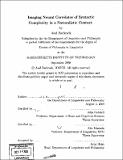| dc.contributor.advisor | John Gabrieli and Alex Marantz. | en_US |
| dc.contributor.author | Bachrach, Asaf | en_US |
| dc.contributor.other | Massachusetts Institute of Technology. Dept. of Linguistics and Philosophy. | en_US |
| dc.date.accessioned | 2009-06-30T16:34:35Z | |
| dc.date.available | 2009-06-30T16:34:35Z | |
| dc.date.copyright | 2008 | en_US |
| dc.date.issued | 2008 | en_US |
| dc.identifier.uri | http://hdl.handle.net/1721.1/45900 | |
| dc.description | Thesis (Ph. D.)--Massachusetts Institute of Technology, Dept. of Linguistics and Philosophy, 2008. | en_US |
| dc.description | Includes bibliographical references (p. 253-280). | en_US |
| dc.description.abstract | The aim of this thesis, and the research project within which it is embedded, is to delineate a neural model of grammatical competence. For this purpose, we develop here a novel integrated, multi-disciplinary experimental paradigm that endorses the fundamental premise of generative grammar, that the study of language is in essence, the study of the mind. We use functional Magnetic Resonance Imaging (fMRI) to monitor brain activation while subjects listen to short narratives. The texts have been written so as to introduce various syntactic complexities (relative clauses, embedded questions, etc.) not usually found (in such density) in actual corpora. We have calculated a number of complexity measures (both at the level of the single word and at that of the phrase) based on current linguistic and psycholinguistic theory and with the use of a computationally implemented probabilistic parser. By correlating these measures with observed brain activity, we are able to identify the different brain networks that support linguistic processing and characterize their particular function. Conversely, we use the rich brain data to inform our cognitive, and linguistic, theory. We report here the neural correlates of surprisal (based on contextual predictions), syntactic complexity, structural ambiguity and disambiguation, Theory of Mind and non-local dependencies. This work made use of novel solutions to compute numerical predictions for these linguistic dimensions, which are often tested only qualitatively, and of a novel parametric fMRI design that allowed for the use of single subject unaveraged data as the dependent variable. The thesis ends with a synthesis of the results in the form of a blue print for a neural model of grammatical competence. | en_US |
| dc.description.statementofresponsibility | by Asaf Bachrach. | en_US |
| dc.format.extent | 280 p. | en_US |
| dc.language.iso | eng | en_US |
| dc.publisher | Massachusetts Institute of Technology | en_US |
| dc.rights | M.I.T. theses are protected by
copyright. They may be viewed from this source for any purpose, but
reproduction or distribution in any format is prohibited without written
permission. See provided URL for inquiries about permission. | en_US |
| dc.rights.uri | http://dspace.mit.edu/handle/1721.1/7582 | en_US |
| dc.subject | Linguistics and Philosophy. | en_US |
| dc.title | Imaging neural correlates of syntactic complexity in a naturalistic context | en_US |
| dc.type | Thesis | en_US |
| dc.description.degree | Ph.D. | en_US |
| dc.contributor.department | Massachusetts Institute of Technology. Department of Linguistics and Philosophy | |
| dc.identifier.oclc | 320526571 | en_US |
